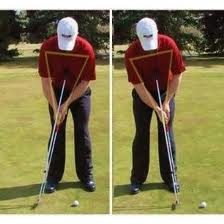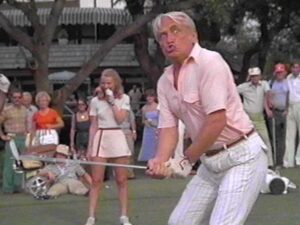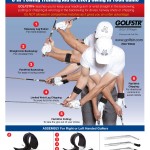Putts are missed as a result of indecision in your mind. You need a process to commit, feel the swing and make the putt. The longer you stand over a putt thinking about your last missed putt, the more your muscles tense and the worse your tempo becomes.
I saw a series of lessons called The Four Factors by putting guru Geoff Mangum. It made me realize that indecision and tension are your 2 worst enemies when you putt.
Here is a 4 step plan to help you sink a lot more putts.
1/ Learn to Hit a Straight Putt:
Place your ball just in front of the center line between your feet to hit the ball on the upswing of the putter face for a true roll of the ball. Learn to swing your putter with the rotation of your shoulders (not your wrists). Follow through with your putter UP your intended putting line. Use your GOLFSTR+ to learn to putt with locked wrists to gain confidence with your putting stroke. Choose your target line. Line-up a line on your ball with your target line. Focus on the line on your ball as you swing your putter to impact on the exact center of the putter face.
2/ Get a Feel for the Green Speed
If you have played this game for any time at all you have a feel for the impact of rolling speed up, down or across a hill or any combination. Unfortunately the speed changes based on when the grass was last cut, rolled and watered. You have no control over these changing conditions so it is up to you to get a feel for the greens on the day that you are playing. Practice putting is a must before you start any round of golf.
3/ Read Your Putt to Choose Your Line:
Walk around the hole and the line of your putt to understand the slope of the green. Read the final roll of the putt from below the hole and choose your line when you are standing below the hole. [When you stand above the hole you tend to lose the perspective of the general slope of the green.] Plan to hit 10 to 18 inches past the hole to allow the speed of the putt to minimize the impact of slope and surface imperfections. For example: When putting across the slope, the smaller the slope the less you should account for the arc as most of it will occur as your ball slows down in the last 10 inches of roll.
Some of the top pros like to “let the putt die into the hole”. Dumb idea as 25% of those putts never reach the hole and 100% of short putts never go into the hole. Slope of the green and distortion at the edge of the hole (from wear and tear around the hole) will always have the greatest impact on the roll of the ball as it slows to a stop. Always plan to putt hard enough to pass the hole by 10 to 18 inches and avoid the worst impact of the slope or distortions of the green. Try to figure out if your ball normally breaks above or below the hole. Then adjust for this and watch your putts drop.
4/ Practice the Right Amount of Swing:
You need to (1) choose your target line and (2) you need to PRACTICE THE RIGHT AMOUNT OF BACK SWING, before you make your putt. Get your spine and shoulders moving. Practice the right length of back swing and follow-through so that you know that you will be putting firm enough to hit 10 to 18 inches past the hole (the same way the best putters in the world did at the Ryder Cup). Feel it in your practice swing and then make that putt.
GOLFSTR+ is a great training aid to help you lock your wrist and get ride of the yips. Click here to buy one and make more putts. Thank you for passing this on to a friend.
————————————————————————————————————————-

If Horschel and Kirk had been on the team, USA would have won the Ryder Cup. When you’re hot you’re HOT and when you’re not . . . .
Congrats to the USA Team for a well fought battle. The amazing part of this story is how the Rookies played. Imagine what could have been had Chris Kirk and Billy Horschel played. Time to move the old guard out.
You may have seen how Patrick Reed suffer through a missed short putt and we all know how this happens. All the more reason to work on your putting game.






